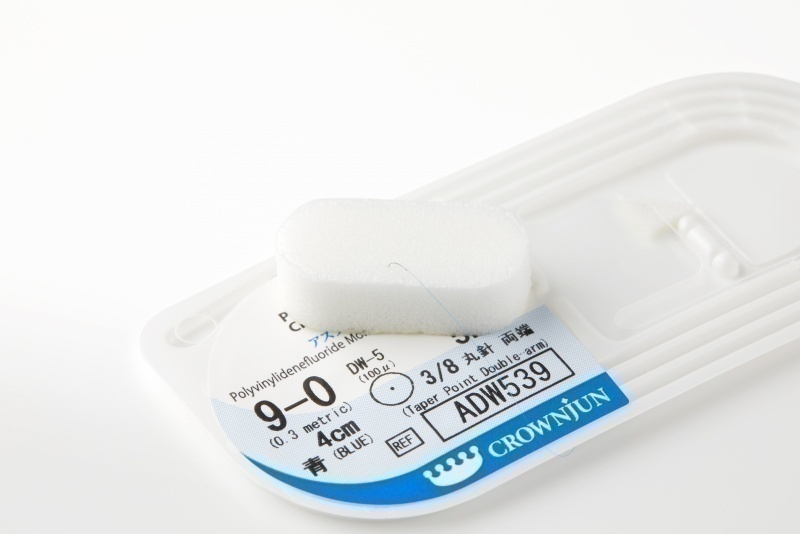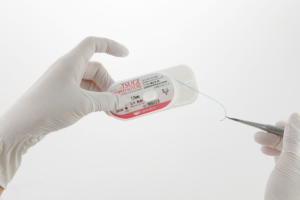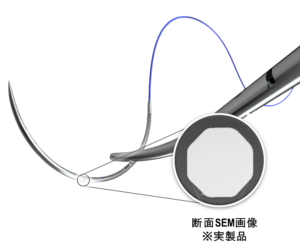Hello. This is Kunii from the Corporate Communications Division!
I was wondering what are the viewers of TSUNAGU are interested in, so I looked back at the blogs so far.
The most viewed article on TSUNAGU is “Learn about Sutures – differences in materials and uses” posted in 2018. I assume that many viewers came to the article to find the answer for: “What exactly are sutures?”
Kono Seisakusho exels in manufacturing of suture needles. Articles about sutures are popular, but there are no articles about needles…
So, today, I would like to write about:
“What kinds of suture needles are there for surgery?” “How are different types of needles used?“
Structure of suture needle for medical use
As many readers of this article may know, most suture needles used in surgery have a very different shape from those used in general handicrafts.
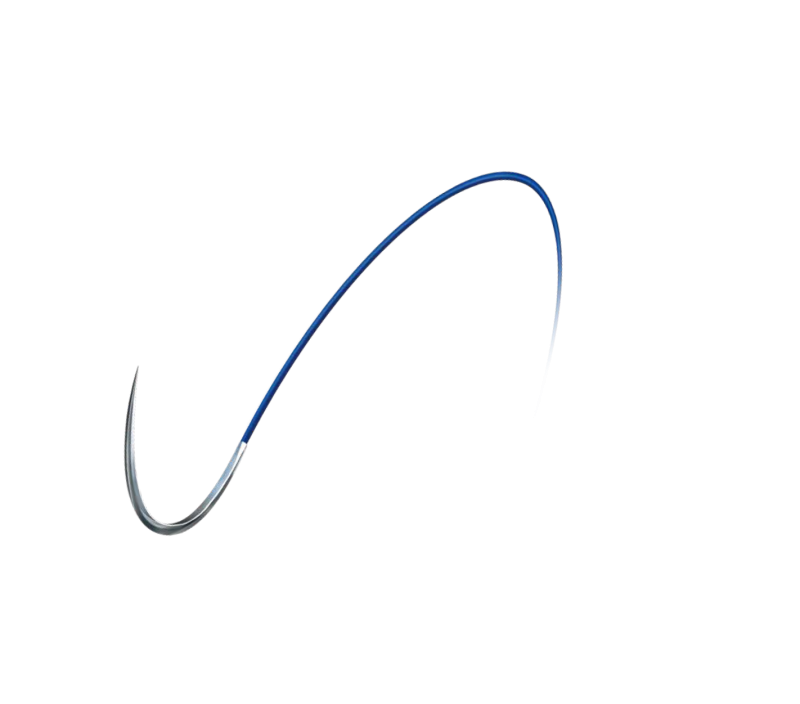
First of all, sutures with needles are sold with the needle and thread connected to each other. This eliminates the need to thread the needle during surgery and prevents the thread from falling out during use, allowing the surgery to proceed smoothly.
Another important feature is that the needle is curved like a bow. In the case of handicraft threads, sewing proceeds by turning and shrinking the cloth, but in the case of surgery, the patient cannot be moved. For this reason, the needle is curved so that the patient can be easily stitched by simply turning the wrist.
In surgery, the degree of curvature, size, and shape of the needle tip that are easy to use differ depending on the site and application. For this reason, we manufacture needles that combine various structures, and we have more than 3,000 types of needles.
Differences in curve
The curves on the suture needle depends on the thickness of the tissue and the depth of the area to be sutured. For example, when anastomosing tissue slightly under the skin, more gentle curve is preferred. But mostly, the decision of the needle largely matters on the doctor’s preference.
The shape of the curve is called as 3/8 Circle (135°) and 1/2 Circle (180 °), resembling the shape of the needle as a circle (360°). The following is a list of typical curves. We can also make needles with curves besides this list, between 0 and 225 °.

Our characteristic needle has the curve of 1/5 circle.
Although it is a very gentle curve, it has made it possible to achieve ease of hand movement that could not be achieved with a straight needle.
A typical example of a suture with the 1/5 circle is “PANCLOOP,” a loop needle for pancreatic jejunal anastomosis.
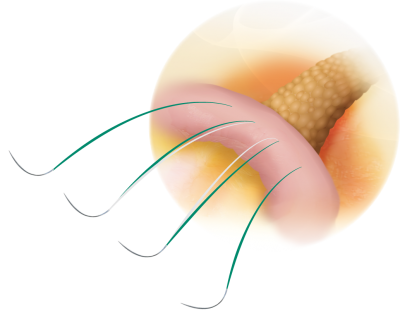
PANCLOOP does not only allows shallow scooping of the jejunum, but it is also possible to penetrate the pancreas like a straight needle, so the pancreas and jejunum are more closely attached and leakage from the needle hole is reduced. Besides its characteristic curve, it is a suture with other features, which I will introduce in another chance.
Differences in Tip
The shape of the needle tip is mainly determined by the area of the body to operate on and the type of surgery to be performed.
When you touch your own body, you may find the difference of the touch between skin and fat, hard fat. It is the same inside our body: skin, organs, and muscles have completely different characteristics, and even in the same area, the characteristics may vary depending on the patient’s age and health condition.
Easy-to-pierce, and the elasting sharpness of the needle is not the only deciding factor for surgeons; sometimes rounded needle tip are chosen to prevent the tissue from tearing.

| Taper Point | Used for soft and easy-to-puncture sites |
| Reverse Cutting | Is able to pierce through tissues smoothly |
| Blunt Point | With a round tip, is able to reduce needle stick accidents on surgeons |
| BlunTaper | With a sharpness between taper point and blunt point, it prevents the tissue from tearing |
| Sharp Edge | Has a charcteristic of taper point and reverse cutting |
| Spatula Cutting | With two tips, is able to scoop tissues in a wide area |
BlunTaper and Sharp Edge are our original needles. The Sharp Edge needle, in particular, has a special needle tip shape that combines the advantages of both Taper Point needle’s ability to pass through tissue without damaging it and Reverse Cutting needle’s high penetrability. The production process is very delicate, so professional craftsmen sharpen the tips one by one by hand.
The difference between pressing
Pressing takes place in the middle part of processing the needles. Usually, the cross section of an unprocessed needle is round, but this causes the needle to slide and spin around when it is grasped. Therefore, the needle is pressed to create a flat surface that makes it easier to grasp. (In some cases, it is better to leave the needle with a round cross-section so that it can be used at any angle.)
Two-side pressed needle, which the upper and lower parts of the needle is flatten, is the basic suture needle. In some surgeries such as cardiovascular surgery, four-side pressed needle is preferred. The sides are flattened in addition to the two-side pressed needle, so the cross section becomes a square-shaped. The ability to grasp the sides of the needle contributes to a conduct delicate operation. This process also has the advantage to increase the strength of the needle.
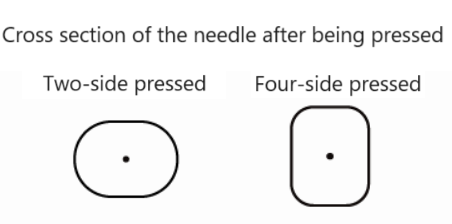
Furthermore, in 2018, we released a unique needle called “Octacus” with an octagonal cross section.
Octacus allows fine adjustment of the needle angle in 45-degree increments while retaining gripping strength. This needle is suitable for surgeries which requires fine needle manipulation, such as cardiovascular surgery.
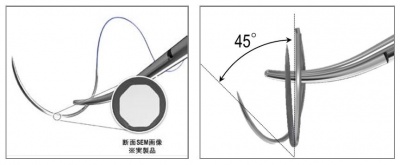
| Octagonal | Is able to change the angle of the needle by 45 degrees each with a firm hold |
| Round | Is able to grab the needle by any angle, but can slide and spin when being hold |
| Rectangular | Is able to change the angle of the needle by 90 degrees each with a very firm fold |
Size differences – from 100 mm to the world’s smallest needle
In addition to the shape of the needle, size is also an important point in performing surgery.
We offer needles with lengths ranging from 100mm to 0.8mm to meet with the needs of various types of surgeries.
The lineups for 3/8 Circle (135°) needles are listed below.

The 0.8mm suture needle is so small that you can barely see it with your naked eye. You can see how small the 0.8mm needle is compared to the 38mm needle and a rice in the picture below.
Kono Seisakusho is famous for this “World’s Smallest Needle“.
This 0.8mm needle has a diameter of 0.03mm (30µm). The diameter of a human hair is said to be 40 to 120µm, so this needle is thinner than a hair.
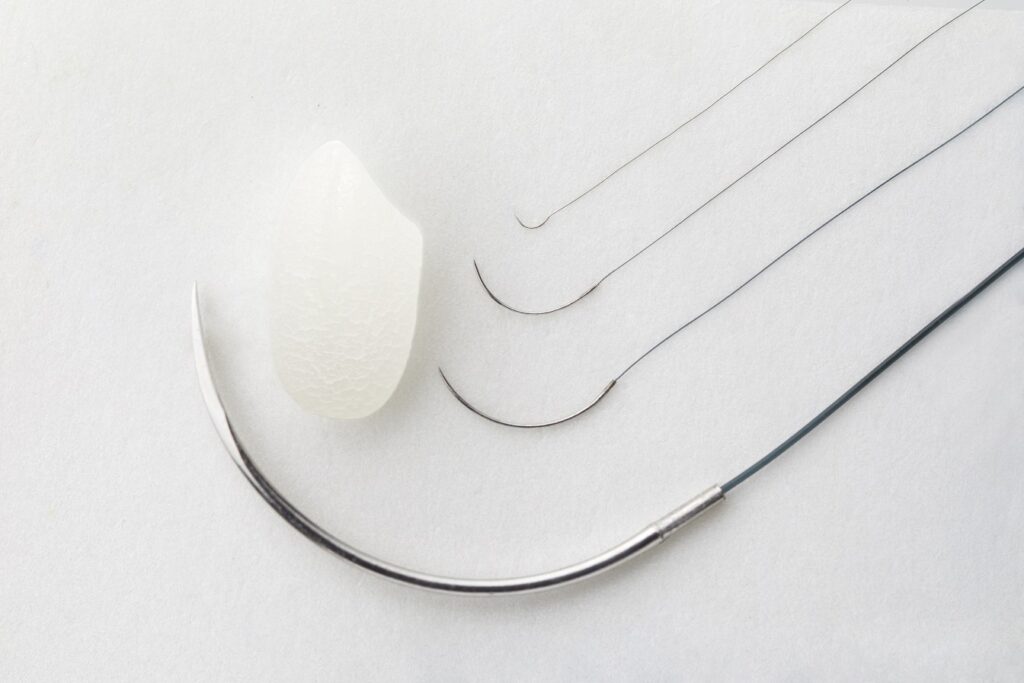
Surgery performed under a microscope using small needles, including needles with a length of 0.8 mm, is called super microsurgery. I will introduce two examples of super microsurgery.
The first is surgery for lymphedema, a disease that can develop after cancer surgery. This is a very painful disease for the patient, which causes swelling of the body and in some cases makes it impossible for the patient to walk. However, with our 30 µm needle, it is now possible to anastomose lymphatic vessels to veins, making lymphedema a disease that can be treated with surgery.
The second is reconstructive surgery. For example, when reconstructing a toe, tissue is brought from the thigh to create the toe. Until the development of our needle thread, we were only able to connect large blood vessels in the deep layers of the muscle, so we had to resect a wide area of the thigh, which was a huge burden on the patient. However, with our needle thread, it is now possible to connect the thin blood vessels around the skin, reducing the burden on the patient. In this super microsurgery, it is sometimes necessary to connect blood vessels as small as 0.3 mm in diameter, and not every surgeons can do it. Our suture needles are able to play an active role thanks to the surgeons.
Characteristic needle of Kono Seisakusho
As a suture manufacturer, Kono Seisakusho has developed many needles to meet the needs of medical professionals.
So far, I have introduced Octacus and PANCLOOP in this article, but there are other recently developed needles, so let me introduce it.
The needle is “ACRI“, a needle made of a new material that entered the market in 2020.
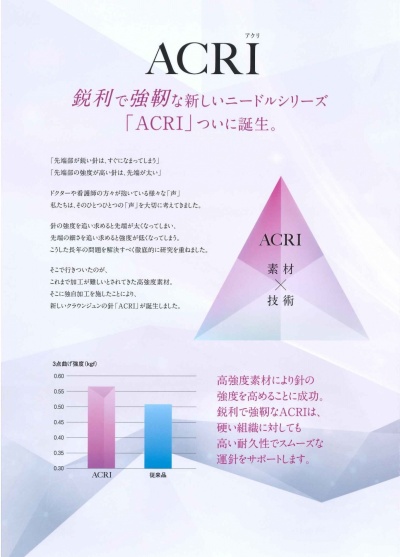
Conventional needle had a dilenma; if it is made thinner for better puncture, it lacks durability during continuous suturing; if the needle is made thicker for greater strength, resistance increases and the patient’s burden increases. ACRI is a needle developed to achieve both “strength” and “sharpness” by using a high-strength material with special processing. The material used in ACRI is difficult to process, so it took many years of trial and error until completing it.
ACRI is already in use, and we have received many comments from surgeons such as, “This is just the kind of needle I wanted,” and, “Even without looking at the package, I can recognize that this is an ACRI needle just by the feeling of suturing!” We hope that the spread of the ACRI needle will help make the surgical process smoother than ever before.
Finally
With thousands of needle lineups, we are able to propose doctors the most suitable needle and thread from a vast number of combinations. We are happy if we can convey to you the appeal of needles, where millimeter-by-millimeter differences in length and curvature have a great impact on the feeling of use.
Visit our stories about needles and sutures

